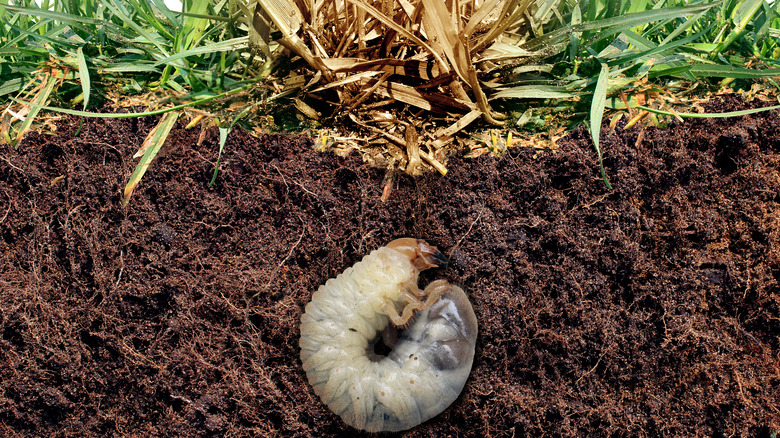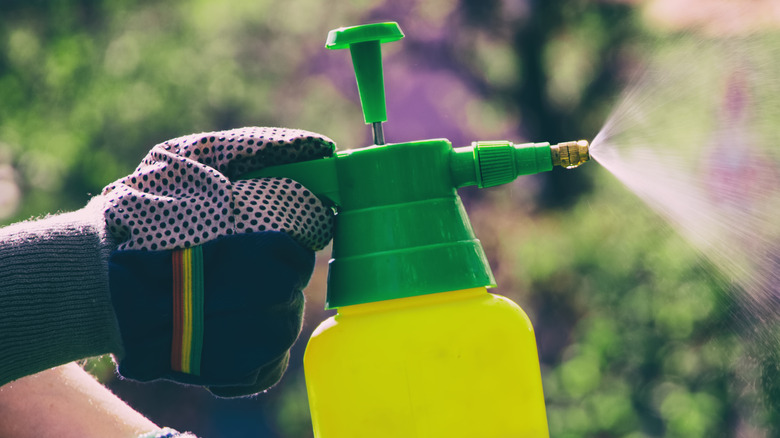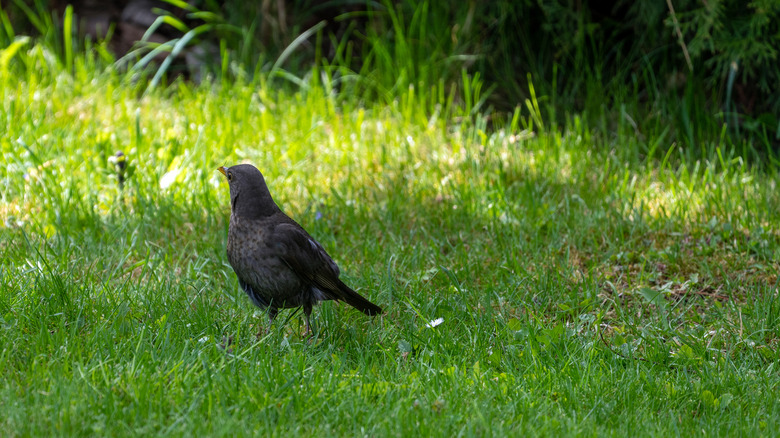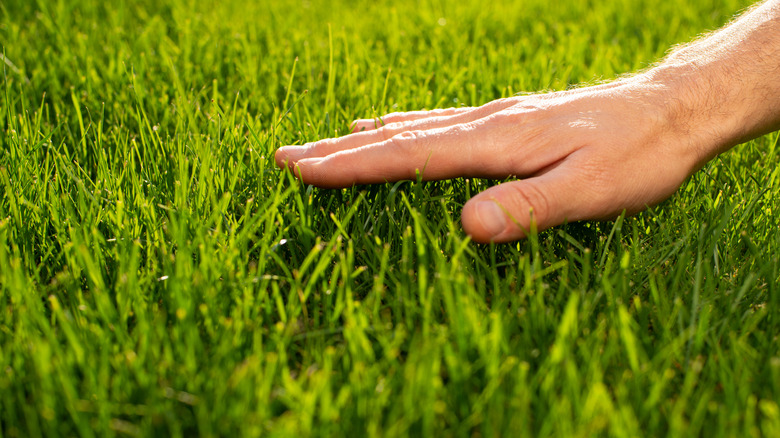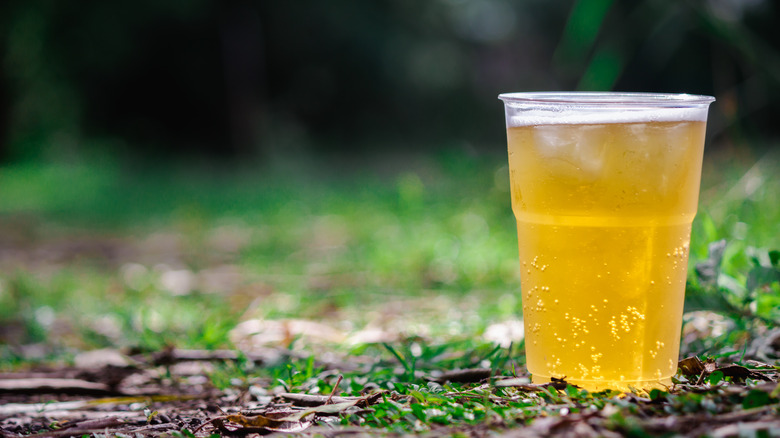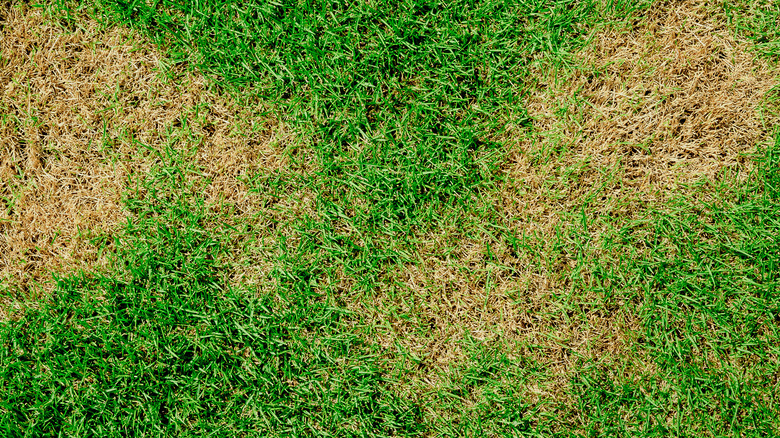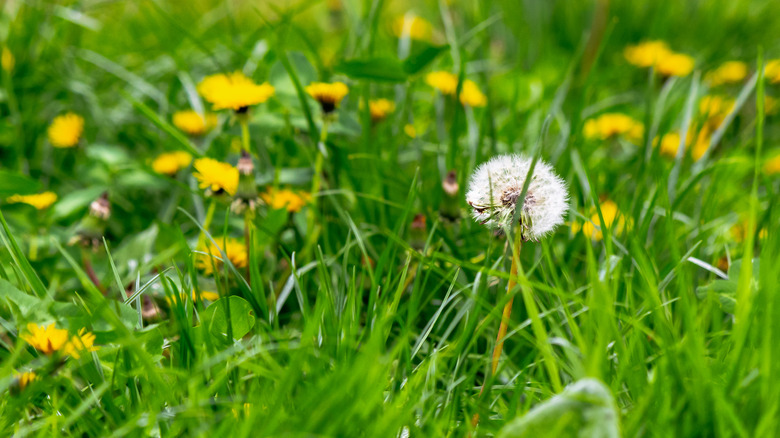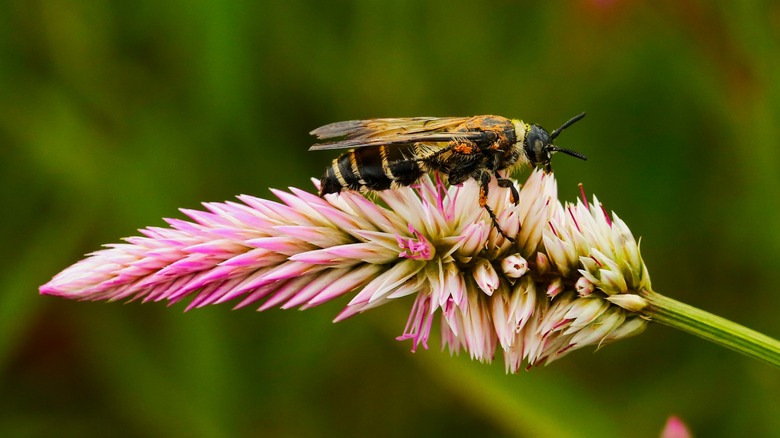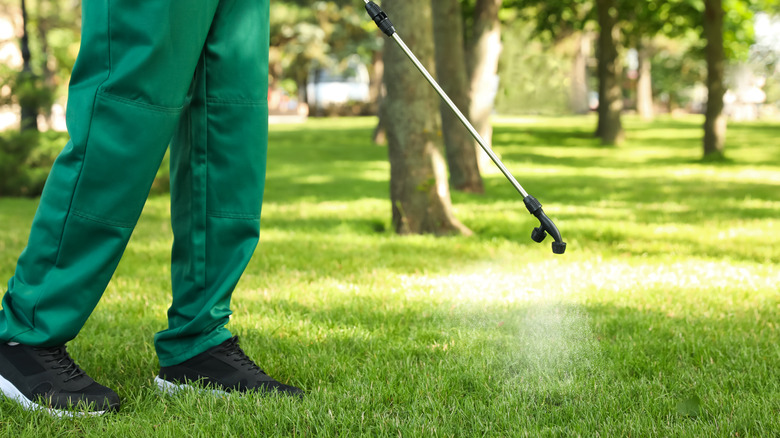Best Ways To Get Rid Of Grub Worms
Are you seeing thinning yellow or brown patches of grass in your yard? The problem might just be an infestation of grub worms, the larvae of scarab beetles that munch on the roots of turfgrass. According to Savvy Gardening, grub worms are common in most gardens and shouldn't be much of a problem in healthy lawns that contain a mixture of grasses, unless you find them in excess — 15 (or more) larvae per square foot. They also populate more easily on lawns that are overfertilized or overirrigated.
Because grub worms live underground, it won't be easy to spot how many have taken up residence on your lawn. One way to identify a grub worm problem is to try peeling back the brown patch of grass. If it comes up easily, like a layer of carpet, then this is likely the work of grub worms that have obliterated the roots. Look for up to 2 inch long insects curled into a C-shape that have a cream coloring and brown heads, Sod Solutions advises.
Once you've confirmed that it's grub worms destroying your lawn, it's time to take action. Lucky for you, there are many tricks to rid your yard of them naturally. Here are eight of the best ways to send grub worms packing.
1. Beneficial nematodes
Beneficial nematodes are microscopic roundworms that attack soil-based pests without harming earthworms, surrounding plants, or pets. Gardening Know How writes that during one of their larval stages, beneficial nematodes seek an underground host, commonly insect larvae like grub worms. Once they've moved in, (and skip this part if you are squeamish!) they mate, lay eggs, and feed on the host tissue. During this process, nematodes introduce a bacteria to the host that typically kills it within 24 to 48 hours.
Per Garden Design, beneficial nematodes often come on a sponge that you soak, add to a sprayer, and distribute along the dirt. They'll need moist and warm conditions to infiltrate your grub worm patches, and it can take up to three years for enough nematodes to build up and kill off a sizable grub worm population. Also, nematode products contain living organisms, so you'll have to use them within a year of purchasing and store them in safe, temperate areas.
2. Milky Spore
Another eco-friendly method used to eradicate grub worms is introducing milky spore, or milky disease, to your soil. It does require some patience, though. Bob Villa notes that it can take several years for the Bacillus popilliae spores to build up, but once they do, they are highly effective without harming beneficial insects.
For milky disease to impact grub worms, the conditions are rather particular. Milky spore comes in a powdered or granule form, according to Yard and Garden Guru, which is ideally applied in early fall when soil is warm and grubworms are packing on weight for winter. They recommend poking holes in the bottom of a coffee can to sprinkle batches of the powder close to the ground in a grid of about four square feet. You'll need about 1 teaspoon in each patch, which you should then add water to gently.
You'll need to reapply as directed on the package instructions, but once introduced, the milky spore should protect your lawn for up to 20 years.
3. Enlist the help of birds
Though they might not be the most reliable ally, birds will happily snack on grub worms, providing a natural way to keep their populations down. Yardener recommends luring insect-hungry songbirds by providing food, water, and shelter near your lawn's problem areas. Along with a bird bath or two and a sizable bird house that might be attractive for nesting, a tip to make those grub worms even more appetizing is to stock a feeder nearby with seed year-round, but reduce the amount of seed in the summertime. That will prompt the birds to hunt for the grub worms in your yard.
The Spruce notes that an added bonus of birds snacking on grub worms is that they will aerate your soil by poking holes to find them. But if you have a sizeable infestation, large birds and small animals might go to town, further damaging and tearing up your lawn.
4. Overseed your lawn
If you don't want to use any chemicals to keep grub worms out of your lawn, try overseeding your lawn. It is an effective and natural way to combat grub worms and restore the health of your turf. Overseeding involves spreading additional grass seed over your existing lawn, which helps to fill in bare patches and promote thick and healthy turf growth. You can purchase grass seeds at most home and garden stores, like Home Depot or Lowe's.
By overseeding, you not only enhance the overall appearance of your lawn but also create a more resilient and dense turf that can better withstand grub worm infestations. The new grass seedlings are more resistant to the feeding habits of grub worms, and their vigorous growth can help to minimize the impact of the pests. Plus, the increased competition for resources among the grass plants can make it more challenging for grub worms to establish themselves in your lawn. As grubs are the larval stage of various beetles, like Japanese beetles or June bugs, they can cause significant damage to lawns by feeding on grass roots. But if most of the grass is young and healthy, and the roots are very crowded, the grubs won't have a chance. And, if you do decide to use chemicals, most products that kill grubs won't impact your seeds.
5. Neem Oil
Neem oil is an extract from Azadirachta indica, according to Plant Care Today. When this substance is eaten by grub worms, neem oil disrupts their growth cycle, causes infertility, and manages to convince them to stop eating and eventually die. Adding neem oil to soil is safe for earthworms and any pets frolicking in your yard, but it must be applied in evenings to avoid harming bees, ladybugs, and other beneficial insects that react to its chemicals when airborne. Luckily, neem oil spray should evaporate within 45 minutes of application, and will last several weeks on your lawn.
To apply neem oil to grub worm-infested soil, add 1 teaspoon of castile soap like Dr. Bronner's to 1 gallon of water, then mix in 2 tablespoons of raw neem oil. Spray the mixture on your lawn up to one time per week until those wormies are gone for good.
6. Beer
If you're willing to part with a can of beer in the name of your yard, you can easily create a trap for grub worms, who can't resist the stuff. Today I'm Home recommends filling a container that's not too high or wide (like Tupperware or a pie tin) halfway with some brew. Dig a small hole near the infested area and place the container inside, and the next day you'll find it filled with grubworms and other bugs. This method works best if you have a few small patches of grass infested with grub worms rather than a giant lawn to remedy.
When using beer to kill grub worms, don't pour it directly onto your lawn. The Lawn Care Nut warns that you'd need an enormous amount of beer to saturate your soil with enough to have an impact on grub worms — and adds that the smell won't be too pretty.
7. Dry out your grass
Another way to eradicate grub worms that have taken up residence in your lawn is to make their comfy digs less tolerable. Bob Vila notes that grub worms need water in order to survive, so if you go ahead and dry out your lawn during the summer months that adult beetles lay eggs, the eggs won't make it through the incubation period. So as long as you're not too attached to having a bright green yard, when summer starts, don't water the grass for three or four weeks –- though your lawn will also dry out, healthy grass won't actually die and will eventually rebound when you start watering it again.
Challenger Irrigation also notes that you should avoid overwatering your lawn to prevent grub worms from moving into your yard in the first place. So when it's rainy or stormy outside, be sure to shut off automatic sprinklers.
8. Avoid mowing your lawn
If grub worms pop up in your lawn every summer, you might particularly enjoy this tip: Take a break from mowing it in order to get rid of them. Plant Care Today writes that adult female beetles look for trim lawns in which to lay their eggs, which need to have both moist soil and warmth from the sun to survive. Keeping your grass 3 to 4 inches high should stave off egg-laying mamas, according to Savvy Gardening. Alternately, overseeding your lawn has a similar effect, creating dense grass conditions that beetles will wind up bypassing.
Additionally, switch to an organic fertilizer if you use a synthetic chemical one on your lawn. Grub worms cause the most damage on lawns that are treated with synthetic fertilizers, so also keep this in mind when you're trying to regrow the patches where grub worms have caused root damage.
9. Scoliid wasps won't sting you, but they will get rid of grubs
Scoliid wasps are beneficial insects that can be highly effective in controlling grub worms in your lawn. These wasps are natural predators of grubs and can play a crucial role in reducing their population. Scoliid wasps dig into the soil to lay their eggs near grub larvae. When the wasp larvae hatch, they feed on the grubs, ultimately killing them. The best part is that these wasps tend to avoid humans and won't sting you "just because." Most stings come from stepping on them.
To attract scoliid wasps to your yard, you can provide nesting sites and food sources. They prefer areas with sandy soil or loose dirt, so creating patches of bare ground can be helpful. You can also plant flowers such as daisies, marigolds, and sunflowers, which provide nectar for the adult wasps. Another option is to purchase scoliid wasps from reputable suppliers who specialize in beneficial insects. These suppliers often sell pupae or adult wasps that you can release into your lawn. However, the availability of scoliid wasps for purchase may vary depending on your location and the time of year. If you are unsure, contact your local horticulture society or garden center for advice specific to your region.
10. Take preventative measures
There are also a few things you can do to your lawn before you even notice grubs to keep them from settling in. The good thing is that these maintenance steps are great for your lawn in general, so doing them will prevent grubs and keep things healthy and thriving. The first is to regularly get rid of thatch. It's a layer of dead grass and debris between the soil and the green grass that can provide an ideal environment for grubs. If there isn't one, your grass will be healthier and there will be less of a chance for grubs to settle in.
If you have a vegetable garden or other susceptible plants to protect from grubs, practice crop rotation to disrupt the life cycle of pests. Avoid planting the same things in the same area year after year. Rotating your plantings can help break the cycle and reduce the chances of grubs building up in the soil. You can also apply organic matter like compost or well-rotted manure to your flowerbeds just before spring. This improves soil health and encourages a robust microbial population, which can help control grub populations naturally.
11. Pesticide
If you have a particularly bad infestation of grub worms in your yard, you might need to bring in the big guns. To that end, there are plenty of commercial pesticide brands that prevent or kill grub worms if you're not interested in testing out natural remedies. One tip from Crabgrass Lawn is to look for insecticides that contain bifenthrin, imidacloprid, or carbary, which kill grub worms upon contact. When applying granular pesticides, water them directly into the soil with a garden spreader, and for liquid solutions, mix with water according to the package directions and spray until the soil is deeply saturated.
The Spruce advises to water your lawn well after applying the chemical pesticides in order to reach grubworms under the root-level. Different brands are used in specific timeframes — some to target larvae, others to kill adult grub worms — so make sure you purchase the right ones for spring or summer months.
